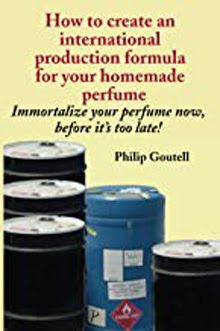I wrote recently about repeatability -- being able to duplicate your fragrance. It sounds simple but sometimes two problems arise. (1) Formulas are lost; (2) the original aroma materials are no longer available. As you might suspect, these problems usually come to light when one of your forgotten fragrances suddenly rings a bell with someone and a new supply is requested. It happened to me just last week.
Here's the story. I'm vacationing at our house in Canada and (slowly) noticed that my wife was wearing a perfume that I hadn't smelt in a while and I suspected it was one I had made for her and long since forgotten.
I asked and she showed me the bottle. It was one of the ones I use for samplers and, rather than a name, it was marked with a code that referenced the formula and date when I had made it. It was from 2005, five years ago! She mentioned that the bottle was almost empty.
Of course I was curious about the fragrance and wanted to look at the formula to see if I might be able to make up a new batch for her. It was not a fragrance I had ever offered for sale.
Speaking frankly, although I liked the aroma (and obviously she did too) my nose easily recognized the rough edges to the formula. If I wanted to offer it for sale today, I would work to smooth it out so that the notes blended more like a fragrant forest rather than standing out like a few tall trees.
But for the moment my task was to find the formula and, if the formula could be found, to see if the aroma materials I had used were still available with their characteristics unchanged.
I looked to my notebooks. Problem. The oldest formula in my hard cover notebooks was from 2007 -- two years short.
The next step was to go to the computer and see if I might still have it in the archives of my ancient copy of The Perfumer's Workbook. Search .... search ... search ... -- and BINGO! Formula found!
Yes, after all these years the formula was still there -- and all of the required materials were on hand and in good condition. A new batch matched the aroma and lifespan of the old batch. Not only could I now reproduce this perfume, I had a good starting point for an "upgrade" that would (if I wanted to do the work!) smooth out the rough edges.
The point of all this is THE NOTEBOOK. When you are working on a perfume -- or even IDEAS for a perfume -- keeping a notebook is of tremendous importance. For each iteration of a project I record the material used (including supplier and supplier's reference code), the date, and -- initially -- the number of drops or half drops or traces of drops used of each material. If I decide to put a formula "into production," drops will be converted to grams and remeasured to check accuracy.
My notebook also includes my impression of each trial and its aging, both on the test blotter and in the mixing pot, as well as my notes to myself on how the formula might be improved in the next trial -- materials added, materials left out, materials changed in proportion. All of this, both for fragrances that were finished and for fragrances that were discontinued, are captured (or were intended to be captured) in these PERMANENT notes.
And you NEVER discard your notebooks.
Improving your skill as a perfumer requires that you learn from both your successes and your failures. And you can expect that there will be far more failures than successes. Memories are short. What I did five years ago is not on the top of my head today. But by going over my notes -- from five years ago -- I can refresh my memory. I can study what I did then. I can think of how I might rework an ancient formula to make a more finished, more refined, perfume today.
Wednesday, July 7, 2010
Subscribe to:
Post Comments (Atom)


No comments:
Post a Comment